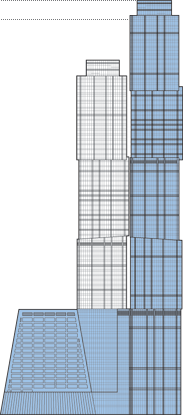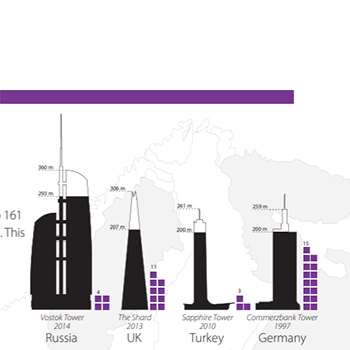Filter by

Capital City
Complex
Completed
residential
Note: Only buildings that have GPS coordinates recorded are displayed.
|
RANK
|
Name
|
Completion
|
Height
|
Floors
|
Function
|
|---|---|---|---|---|---|
| 1 | Capital City Moscow Tower | 2010 |
302 m / 990 ft |
76 | Residential |
| 2 | Capital City St. Petersburg Tower | 2010 |
257 m / 844 ft |
65 | Residential |
1 June 2013 - CTBUH Journal
1 September 2011 - Event

01 June 2013
CTBUH Research
There are currently 109 skyscrapers over 150 meters in Europe. This number is set to jump to 161 by the end of 2015, meaning that...

01 June 2013
CTBUH Research
There are currently 109 skyscrapers over 150 meters in Europe. This number is set to jump to 161 by the end of 2015, meaning that...

13 April 2011
CTBUH Research
Tall buildings are spreading across the globe at an ever-increasing rate. This study demonstrates the relationship between population and tall buildings across those countries and...

06 April 2011
Yuri Starodubtsev, Capital Group; Joey Myers & Larry Goetz, NBBJ
As a pioneering project in Moscow, Capital City has forged many new pathways for the city’s real estate and construction industries. Through its integrated design...

31 December 2010
CTBUH Research
In a year dominated by news coverage of the new “World’s Tallest Building” – Burj Khalifa, Dubai – one may be surprised to learn that,...
1 June 2013
There are currently 109 skyscrapers over 150 meters in Europe. This number is set to jump to 161 by the end of 2015, meaning that there are more than 50 projects in advanced stages of construction.
2 September 2011
CTBUH Chairman Professor Sang Dae Kim held tall building lectures in Thailand, Vietnam, Indonesia and Russia with the dual purpose of promoting CTBUH and the 2011 Seoul Conference.
13 April 2011
Tall buildings are spreading across the globe at an ever-increasing rate. This study demonstrates the relationship between population and tall buildings across those countries and presents information on the average height and age of each country’s tallest buildings.
31 December 2010
In a year dominated by news coverage of the new “World’s Tallest Building” – Burj Khalifa, Dubai – one may be surprised to learn that, besides being the year in which a building first surpassed the 600, 700, and 800-meter thresholds, 2010 has seen the completion of more skyscrapers than any previous year in history.
Subscribe below to receive periodic updates from CTBUH on the latest Tall Building and Urban news and CTBUH initiatives, including our monthly newsletter. Fields with a red asterisk (*) next to them are required.
View our privacy policy